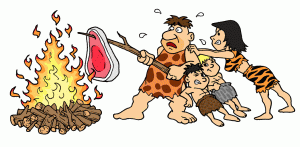Dutch oven Cooking in the Cold
Hi everyone! I am very pleased to present to you another guest post. This post is from Mark Hanson of Utah, USA and he write a blog called Mark’s Black Pot, it's a blog that I read with great interest. He is also a Musician! I hope you enjoy his writing as much as I do.
Cookin’ in the Cold
By Mark Hansen
As winter approaches, many folks will put their dutch ovens into storage. There are various methods of “winterizing” them, most of them involving making sure they’re clean and dry and don’t have a lot of oil in the bottom that can go rancid before they get pulled out again in the late spring or early summer. After all, cooking outdoors is for warm weather, right?
At my house, I have a simple method of keeping my dutch ovens ready for spring: I use them all winter. The herbal roast turkey is now a family Christmas tradition, as is the pumpkin pie for post-Halloween. A couple of other favorites include the Russian Coulibiac on a January afternoon, and the Snow Crab Legs (literally!).
Now, keep in mind, I’ve only been dutching for about two and a half years. That’s only two winters and they’ve not been the harshest I’ve ever seen, either. Utah winters are cold and snowy, but not always with the bitter wind chill that more humid climates bring. Still, I have learned a thing or two that I can share.
Let me also state, for the record, that I’m not cooking these dishes “in the wild.” Virtually all of my cooking is done on my back porch. As a result, I’m not standing out shivering while my food cooks. I’m inside, snug, usually watching whatever my kids have on the TV. This is not “roughing it” by any stretch of the imagination.
I’ve found that in winter cooking there are primarily four issues you have to deal with: Cold, Wind, Rain, and Snow.
Dealing with the Cold
This is probably the simplest of all issues to adapt to: Simply add more coals. How many? Well, that depends on how cold it is. If you’re dealing with general winter-y temperatures of, say, between 20°F and 40°F I’d probably start with two extra coals below, and three to four above, in basic baking and roasting. More if it’s colder, and less, if warmer.
What you’re cooking also makes a difference. If you’re cooking a stew, then you’ve got more flexibility, because you can go a bit hotter with less risk of burning. If your heat is too low, you simply cook it longer. If you’re doing bread, then it’s more critical to get the heat right. Too much heat can burn. In that case, I would err on the side of caution and not pile on the coals too high.
 Another thing I’ve learned is that it’s best to get the ovens up off the ground. I used to put my dutch ovens on paving bricks, until I learned I was losing a lot of heat from the bottom coals to heating up the brick. Now, I have these short metal tables/stands that I use. These are great, since they allow you to get the oven up off the ground. They also do a good job of reflecting much of the radiant heat back up into the dutch oven. I can actually reach my hand underneath these stands comfortably, and not feel the heat.
Another thing I’ve learned is that it’s best to get the ovens up off the ground. I used to put my dutch ovens on paving bricks, until I learned I was losing a lot of heat from the bottom coals to heating up the brick. Now, I have these short metal tables/stands that I use. These are great, since they allow you to get the oven up off the ground. They also do a good job of reflecting much of the radiant heat back up into the dutch oven. I can actually reach my hand underneath these stands comfortably, and not feel the heat.
Dealing with the Wind
A lot of cooks I know have fancy tables with wind screens, or wind blockers made of sheet metal, in all kinds of configurations. I’ve got mixed feelings about that. I think that wind, if you understand it and plan for it, can actually be your friend. Wind blowing across the coals feeds them more oxygen, stoking them up, so they actually burn hotter. When it’s cold outside, that can be a good thing.
The downside is that it’s a little tougher to regulate the temperature, since gusts will come and go. So, if you’re doing a dish where steady temperature is more critical, like bread, you might want to go with a wind screen, or rotate the dutch oven more frequently, to avoid hot spots.
Also, keep in mind that since the coals are burning hotter, they will also burn faster so, you need to replenish them more often.
Dealing with the Rain
There are two basic problems with dutchin’ in the rain. One is that the rain could put out your coals. The other is that if it starts raining pretty hard pretty quickly, the cold rain on the hot dutch oven could crack or damage it. Either scenario is not pretty.
Generally speaking, if it looks like rain, I’ll cook under some shelter. My front porch is covered so, it’s still ventilated, but I’m not getting rained on. I have set up my dutch ovens in my garage, but I caution you about that. Charcoal gives off carbon monoxide and could be deadly. My garage is also well ventilated. I can open the big doors in front, and a door in the back and the winds blow through. I don’t know scientifically if it would make a difference, but speaking personally, I wouldn’t do dutch oven in an enclosed space with only one door open. The air would have to be able to flow through the space.
My in-laws gave me this big round cylindrical metal hood that’s supposedly designed to cover dutch ovens. It works, and I can even stack two 12” dutch ovens under it, but, even though there are holes around the lower rim and a vent on top, it doesn’t allow enough air circulation. I’ve had times, trying it out, where it actually extinguished the coals. I don’t recommend it.
One quick and easy solution that might work, if there’s not too much wind, would be to set up a big patio umbrella over the ovens.
Dealing with the Snow
Problems with snow would be very similar to problems with the rain. I’ve found that, unless it’s a freaky-white-out blizzard, I can continue cooking in flurries or even relatively steady snow. Covering it somehow is a good strategy, like the umbrella or the hood, as long as you can keep air flowing over the coals.
Ultimately, in all of this, even though I’m cooking from the relative comfort of my heated home, I still think from time to time about my pioneer ancestors that had to cook in their dutch ovens regardless of the weather. If they didn’t cook, they didn’t eat. So, is it possible to make good food in tough weather? Yes. Don’t let it stop you!
Thank you Mark for a great article! I know you just answered a lot of question that Dutch oven cooks have. I hope everyone visits Marks Blog Mark’s Black Pot, make sure to tell him hi from Cooking Outdoors!!
Gary

